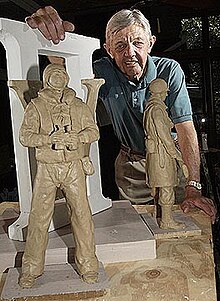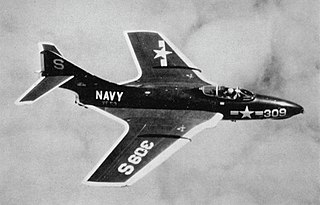
The Grumman F9F/F-9 Cougar is a carrier-based jet-powered fighter aircraft designed and produced by the American aircraft manufacturer Grumman.

VFA-31 or Strike Fighter Squadron 31 is known as the Tomcatters, callsign "Felix", a United States Navy strike fighter squadron stationed at Naval Air Station Oceana flying the F/A-18E Super Hornet. The Tomcatters are the second oldest Navy Fighter Attack squadron operating today.

William Patrick "Willy Irish" Driscoll is a retired commander in the United States Navy and a flying ace. Driscoll, a Naval Flight Officer, and aircrewmate Duke Cunningham, a Naval Aviator, were their service's only aces of the Vietnam War. They remain the Navy's most recently minted aces.
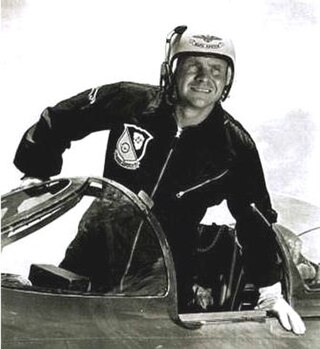
Captain Roy Marlin "Butch" Voris was an aviator in the United States Navy, a World War II flying ace, and the founder of the Navy's flight demonstration squadron, the Blue Angels. During his 22-year naval career Voris flew everything from biplanes to jets, and afterward was instrumental in the development of the Navy's F-14 Tomcat strike fighter and NASA's Apollo Lunar Module (LM), both produced by the Grumman Aerospace Corporation.
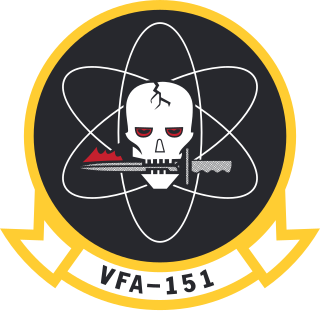
Strike Fighter Squadron One Five One (VFA-151) nicknamed the Vigilantes are a United States Navy F/A-18E Super Hornet fighter squadron stationed at Naval Air Station Lemoore, California. The squadron is a part of Carrier Air Wing 9 (CVW-9). As part of CVW-9, the squadron's tail code is NG and its radio callsign is "Ugly".

Strike Fighter Squadron 11 (VFA-11) is a United States Navy strike fighter squadron stationed at Naval Air Station Oceana, Virginia, United States. The squadron was established in 1950 and is nicknamed "Red Rippers". VFA-11 is equipped with the Boeing F/A-18F Super Hornet and currently assigned to Carrier Air Wing One.
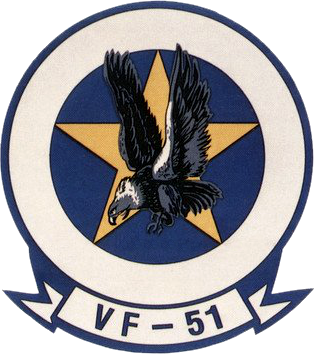
VF-51, Fighter Squadron 51 was an aviation unit of the United States Navy known as the "Screaming Eagles". It was originally established as VF-1 on February 1, 1943, redesignated as VF-5 on July 15, 1943, redesignated as VF-5A on November 15, 1946, redesignated VF-51 on August 16, 1948, and disestablished in March 1995. Until its disestablishment, VF-51 was the oldest fighter squadron in continuous service with the Pacific Fleet.

Strike Fighter Squadron 101 (VFA-101), also known as the "Grim Reapers", was a United States Navy Fleet Replacement Squadron (FRS) based at Eglin AFB, Florida. After the West Coast FRS for the F-14 Tomcat, VF-124, was disestablished in the mid-1990s, VF-101 became the sole F-14 FRS. At the time it was based at NAS Oceana in Virginia. With the retirement of the F-14, VF-101 was deactivated in 2005. It was reactivated in 2012 and redesignated Strike Fighter Squadron 101 (VFA-101). It was one of two F-35C Lightning II FRS before being deactivated in 2019. It was based at Eglin AFB, Florida with the joint 33d Fighter Wing, as a subordinate unit of the U.S. Navy's Strike Fighter Wing, U.S. Pacific Fleet.

Fighter Squadron 124 or VF-124Gunfighters was a fleet replacement squadron (FRS) of the United States Navy. Originally established on 16 August 1948 as VF-53, it was redesignated VF-124 at NAS Moffett Field on 11 April 1958 due to a need for an increased number of flight training squadrons, itself necessary because of introduction of swept wing fighters into Navy service. In 1961, the squadron relocated to NAS Miramar, California, which would become the U.S. Pacific Fleet's Master Jet Base for fighter aircraft.

Strike Fighter Squadron 143 (VFA-143), also known as the "Pukin Dogs," is a United States Navy strike fighter squadron based at Naval Air Station Oceana, Virginia. The Pukin Dogs are an operational fleet squadron and flying the F/A-18E Super Hornet. They are currently attached to Carrier Air Wing One and USS Harry S Truman. They are currently at their homeport of NAS Oceana. Their radio callsign is Taproom.

Fighter Squadron 194 (VF-194) was an aviation unit of the United States Navy. It was originally established as VF-91 on 26 March 1952, redesignated VF-194 on 1 August 1963 and disestablished on 1 March 1978. It was the third US Navy squadron to be designated VF-194.

Fighter Squadron 53, or VF-53Iron Angels was an aviation unit of the United States Navy in service from 20 July 1950 to 29 January 1971. Originally established as reserve squadron VF-721 on 20 July 1950, it was redesignated as VF-141 on 4 February 1953 and then redesignated as VF-53 on 15 October 1963. The squadron was disestablished on 29 January 1971. It was the fourth US Navy squadron to be designated as VF-53.

Strike Fighter Squadron 113 (VFA-113), also known as the "Stingers," is a United States Navy strike fighter squadron based at Naval Air Station Lemoore, California. They are an operational fleet F/A-18E Super Hornet squadron attached to Carrier Air Wing 2 (CVW-2) and based at NAS Lemoore, California. Their tailcode is NE and their radio callsign is Sting.

John "Jack" Lawrence Finley was a United States Navy aviator and was selected as an astronaut.

Donnie L. Cochran is a former United States Navy naval aviator and was the first African-American aviator to be selected to the Flight Demonstration Squadron Blue Angels in 1986. Cochran later assumed command of the Blue Angels in 1994. He is a 2022 inductee to the Georgia Aviation Hall of Fame.

Strike Fighter Squadron 192 (VFA-192), also known as the "World Famous Golden Dragons", are a United States Navy F/A-18E Super Hornet fighter squadron stationed at NAS Lemoore.

VF-121 of the US Navy was a former Pacific Fleet Replacement Air Group (RAG) unit. Originally established on 1 July 1946, as VF-781, it was redesignated as VF-121 on 4 February 1953 and disestablished on 30 September 1980. On 11 April 1958 it changed duty from Fleet Squadron to Fleet Replacement Squadron and was later charged with the training of Navy F-4 Phantom flight and maintenance crews.

Fighter Squadron 96, or VF-96Fighting Falcons was an aviation unit of the United States Navy in service from 1962 to 1975. When assigned to Carrier Air Wing Nine (CVW-9) their tailcode was NG, and their radio callsign was Showtime. Originally established as United States Naval Reserve squadron VF-791Fighting Falcons on 20 July 1950 it was redesignated VF-142 after becoming a regular squadron on 4 February 1953. It was re-designated VF-96 on 1 June 1962 and disestablished on 1 December 1975.

Fighter Squadron 111 (VF-111), also known as the Sundowners, was a fighter squadron of the United States Navy. Originally established as Attack Squadron 156 (VA-156) on 4 June 1955, it was redesignated VF-111 on 20 January 1959, the day after the original VF-111 was disestablished. The squadron was redesignated VF-26 on 1 September 1964, redesignated as VF-111 on 17 September 1964 and disestablished on 31 March 1995.
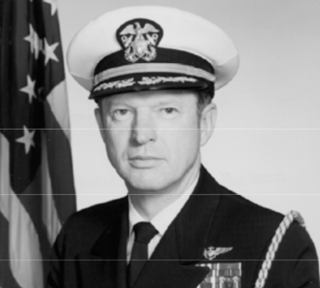
Elmer Royce Williams is a retired United States naval aviator. He is known for his solo dogfight with seven Soviet pilots during the Korean War, which, according to The San Diego Union-Tribune, has been called "one of the greatest feats in aviation history" by military experts. A retired admiral and multiple members of Congress have been campaigning for him to receive the Medal of Honor for his exploit. On January 20, 2023, he received the Navy Cross—the highest military decoration awarded by the U.S. Navy—from Secretary of the Navy Carlos Del Toro.
